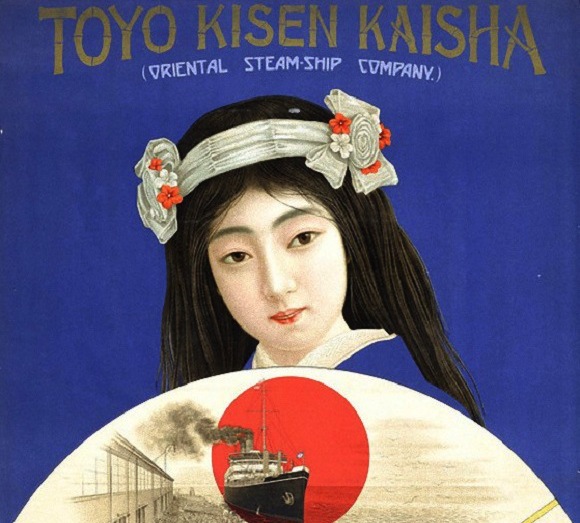
If we could have a genie grant only one wish, it would likely be for a time machine. Even going back a mere 100 years would be fascinating, but, alas, genies aren’t real. Or, if they are, the world governments are keeping them tightly under wraps.
Fortunately, we don’t need time machines to sneak peeks back in time–all we need are some awesome, full-color posters. And these 17 posters are the next best thing to finding Doc Brown waiting outside with a revving DeLorean!
These posters are leftovers from the Taisho and early Show periods, which in case you’re having trouble remembering you history class, were roughly 1912 to 1926 and 1926 to 1989, respectively. To say that they represent a different time would be putting it mildly–the periods come second only to the Meiji period in terms of modern social upheaval. But the posters are as beautiful as they now seem foreign.
Though the above English-language poster is clearly targeting an American audience–notice it is advertising a San Francisco Line–and was likely made in the US, the company that produced it was entirely Japanese. Toyo Kisen Kaisha ran lines that traveled throughout the Pacific, including destinations such Hong Kong, Manila, and Shanghai. For a look at the state of international business in 1906 (just at the end of the Meiji period), be sure to check out this article from the San Francisco Call about the arrival of Toyo Kisen Kaisha’s general manager M. Shiraishi in the City by the Bay.
As you can probably tell from the title of the poster, this was for an air show, held from March to May in 1921 in Kyushu. The landscape beneath the plane is apparently a depiction of the hot springs in Beppu. Can we just say we’re glad to live in a time when airplanes don’t look like they’re made out of cardboard?
Not quite as exciting as some of the other posters on this list, this view of women by the sea is for the Nippon Yusen Kaisha–a mail/delivery company. If only UPS had such cool posters now!
A beautiful image of a five-story pagoda, deer, and the branches of a wisteria tree, this Japan Tourist Bureau poster would certainly spark the interest of anyone looking for a quiet getaway.
As you’ve probably figured out from the image, this is a poster for Planton fountain pens and ink. We’re hoping the illustration was drawn to scale…
One of the stranger posters on this list, this is for the Dainihon Seitou Kabushikigaisha, or the Great Japan Sugar Manufacturing Corporation. We have no idea what this woman has to do with making sugar, but you do have to admit that she sure does look classy.
Another shipping company, the Nanyou Yusen Kaisha was also apparently one more of Japan’s early international corporations. It’s hard to make out, but the text at the bottom of the poster is in both Japanese and English and appears to offer a guide to services available to customers.
This poster is actually for a railway that was in China–and originally built by the Germans between 1899 and 1904. The railway was apparently located in territory that the Germans took from China in the late 19th century and was later captured by Japanese and English forces. Though Japan originally gained ownership of the land in 1917, it was returned to China in 1922, who controlled it until Japan recaptured the area in World War II.
Despite the image gracing this poster, it was produced by an American company–the Pacific Mail Steamship Company. Though the company was ostensibly a shipping company, it also carried passengers and apparently played a large role in bringing Asian immigrants to California.
While the postal service may not be who you’d normally turn to for life insurance in many countries, it might be your best bet in Japan! This poster extols the virtues of enrolling in postal life insurance, which includes making you feel safe, helping you and your family avoid trouble during unfortunate times, and allowing you to save money without realizing it.
This is a poster for the Ministry of Communication and Transportation, which was dissolved in 1949. The ministry was responsible for postal devices, telegrams, railways, and so on. The text read: “Saving money is like a root. Peace is like a flower.” Which is another way of saying if you save money, you will have peace of mind–good advice no matter the time period!
Produced by the Ministry of Railways (restructured in 1943), this poster shows all the rail lines available in Japan at the time of printing.
This colorful image was, obviously, an advertisement for the Osaka Shosen Kaisha–or the Osaka Mercantile Steamship Company. The white flag in the top left corner bears the symbol of the company: The kanji 大, which is also the first kanji in Osaka (大阪).
This is a poster for a brand of soap which could be translated literally as “crane’s egg soap,” which was believed to be excellent for getting beautiful skin. We’re guessing no eggs were actually used in the soap…
Cuttle Fish was a snack food which was apparently high in calcium. With squid as a main ingredient, it was apparently considered a bit of a delicacy at the time. And we’re betting it was a friend of anyone who was lactose intolerant!
An advertisement for a graphic art exposition held by the Ministry of Education, Science and Culture at a print museum in Tokyo, this poster has a distinctly abstract feel to it. It almost reminds us of early science fiction!
This poster is an advertisement for printing factoryTokyo Tsukiji Katsuji, and bears the image of Benzaiten–a deity associated with the flowing of water, word, music, and knowledge–carrying a biwa.
Until scientists figure out that whole going “backwards in time,” we’ll just have to be happy with colorful posters. Hey, at least we don’t have to worry about falling in love with our grandparents this way!
Source/images: Karapaia

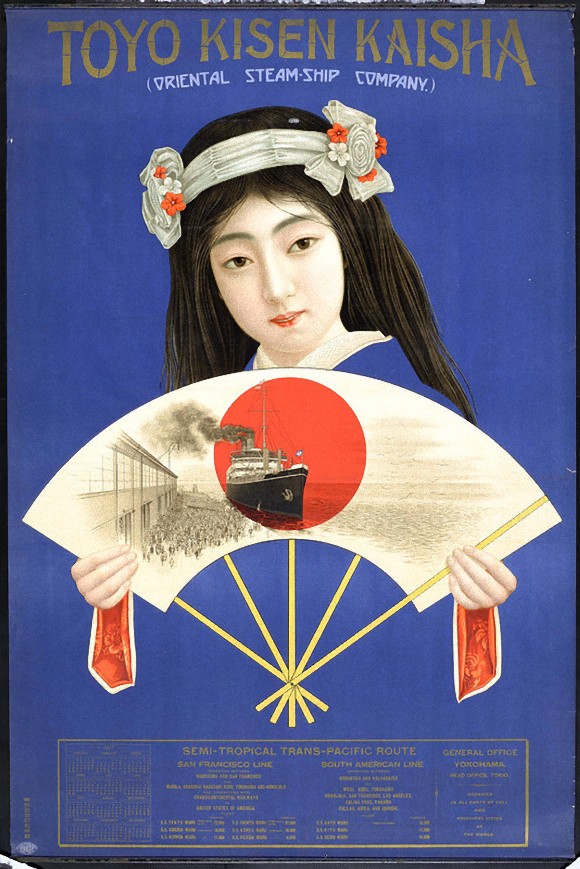


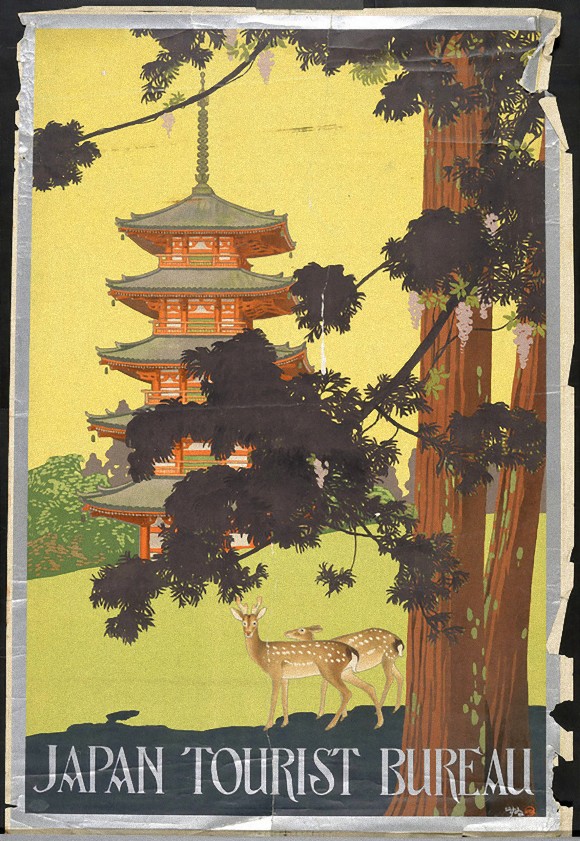




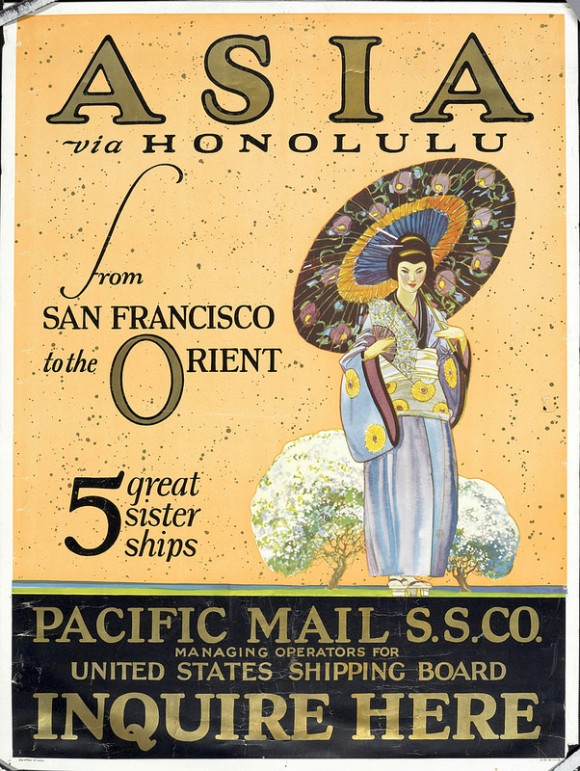

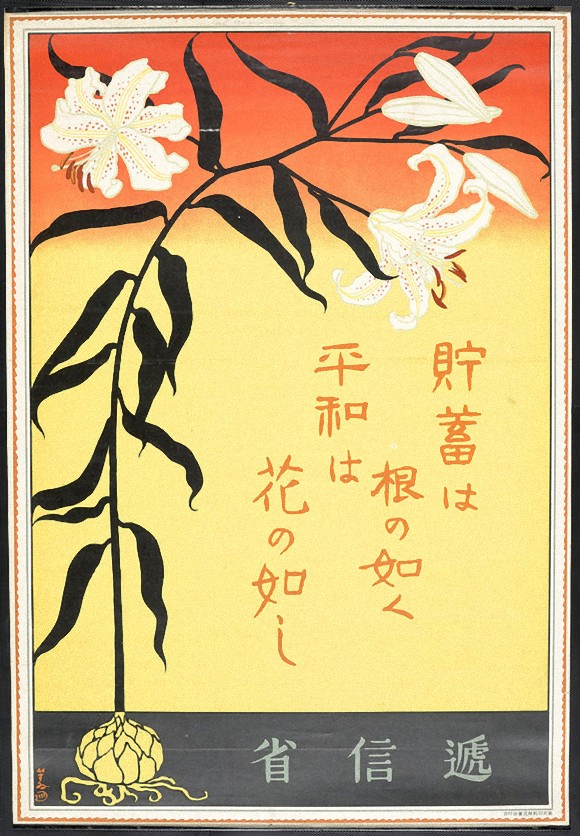



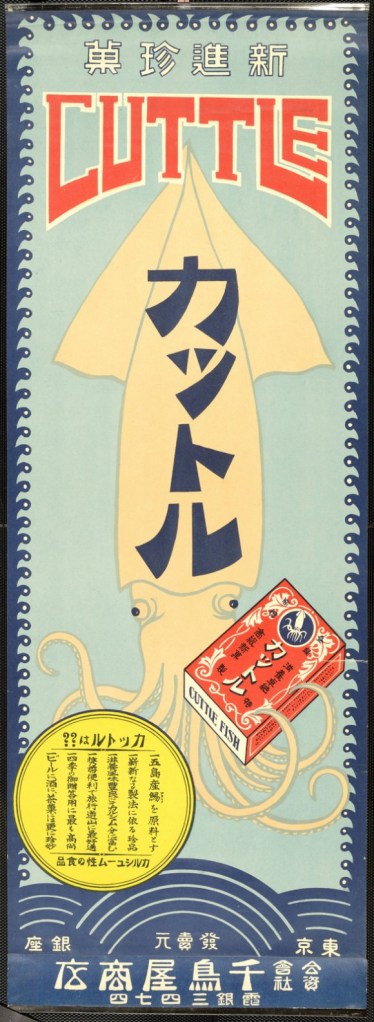


 Merchant shipping posters invoke romance and wonder of Japan’s Meiji, Taisho and Showa eras
Merchant shipping posters invoke romance and wonder of Japan’s Meiji, Taisho and Showa eras Travel back in time with these tourism posters from early 1900s Japan 【Pics】
Travel back in time with these tourism posters from early 1900s Japan 【Pics】 New train recreates hotel atmosphere with wood interiors and views from the foot of Mount Fuji
New train recreates hotel atmosphere with wood interiors and views from the foot of Mount Fuji Hello Kitty Choco Egg figures are an adorable trip through three periods of Japanese pop culture【Pics】
Hello Kitty Choco Egg figures are an adorable trip through three periods of Japanese pop culture【Pics】 Is the Japanese Word for “Thank You” Losing Its Meaning?
Is the Japanese Word for “Thank You” Losing Its Meaning? Pizza Hut Japan’s hot lucky bags are perfect for a New Year’s pizza party
Pizza Hut Japan’s hot lucky bags are perfect for a New Year’s pizza party Japanese group to hold fashion show of colostomy bags and other stoma equipment in Paris
Japanese group to hold fashion show of colostomy bags and other stoma equipment in Paris Dragon Quest Slime toys appear at McDonald’s Japan in crossover with Grimace and pals【Video】
Dragon Quest Slime toys appear at McDonald’s Japan in crossover with Grimace and pals【Video】 7-Eleven Japan’s ramen-cooking robot whipped us up a bowl of noodles【Taste test】
7-Eleven Japan’s ramen-cooking robot whipped us up a bowl of noodles【Taste test】 Should you turn your bowl upside down after eating at a Japanese restaurant?
Should you turn your bowl upside down after eating at a Japanese restaurant? The Japanese language has a special honorific suffix just for talking to athletes
The Japanese language has a special honorific suffix just for talking to athletes Harajuku’s new permanent Tamagotchi shop is filled with cuteness and a surprising lack of poop
Harajuku’s new permanent Tamagotchi shop is filled with cuteness and a surprising lack of poop Starbucks Japan ready to get Year of the Horse started with adorable drinkware and plushies【Pics】
Starbucks Japan ready to get Year of the Horse started with adorable drinkware and plushies【Pics】 Cyberpunk anime meets traditional culture in Ghost in the Shell gold leaf Japanese changing screens
Cyberpunk anime meets traditional culture in Ghost in the Shell gold leaf Japanese changing screens 7 great places to see Mt. Fuji from without having to climb it
7 great places to see Mt. Fuji from without having to climb it Japan’s otoshidama tradition of giving kids money at New Year’s gets a social welfare upgrade
Japan’s otoshidama tradition of giving kids money at New Year’s gets a social welfare upgrade We found possibly the quietest Japanese-style hotel in Tokyo’s bustling Shinjuku district
We found possibly the quietest Japanese-style hotel in Tokyo’s bustling Shinjuku district Lacquerware supplier to emperor of Japan and Pokémon team up for new tableware
Lacquerware supplier to emperor of Japan and Pokémon team up for new tableware Sumo Sanrio! Hello Kitty and pals team up with Japan Sumo Association for new merch【Pics】
Sumo Sanrio! Hello Kitty and pals team up with Japan Sumo Association for new merch【Pics】 Can a dirty butthole make you filthy rich in Japan? We’re starting a New Year’s lottery experiment
Can a dirty butthole make you filthy rich in Japan? We’re starting a New Year’s lottery experiment 7-Eleven Japan starts new temporary luggage storage service in over 300 branches
7-Eleven Japan starts new temporary luggage storage service in over 300 branches Disillusionment at Tsukiji’s tourist-target prices led us to a great ramen restaurant in Tokyo
Disillusionment at Tsukiji’s tourist-target prices led us to a great ramen restaurant in Tokyo Starbucks teams up with 166-year-old Kyoto doll maker for Year of the Horse decorations【Photos】
Starbucks teams up with 166-year-old Kyoto doll maker for Year of the Horse decorations【Photos】 Tokyo considering law requiring more trash cans following litter increase in heavily touristed area
Tokyo considering law requiring more trash cans following litter increase in heavily touristed area Tokyo’s Tsukiji sushi neighborhood asks tour groups to stay away for the rest of the month
Tokyo’s Tsukiji sushi neighborhood asks tour groups to stay away for the rest of the month Nintendo’s Kirby now delivering orders at Kura Sushi restaurants, but not in Japan
Nintendo’s Kirby now delivering orders at Kura Sushi restaurants, but not in Japan Tokyo event lets you travel back in time, for free, to celebrate 100 years since Showa era start
Tokyo event lets you travel back in time, for free, to celebrate 100 years since Showa era start Sanrio theme park in Japan announces plans to expand into a Sanrio resort
Sanrio theme park in Japan announces plans to expand into a Sanrio resort Japan may add Japanese language proficiency, lifestyle classes to permanent foreign resident requirements
Japan may add Japanese language proficiency, lifestyle classes to permanent foreign resident requirements Survey asks foreign tourists what bothered them in Japan, more than half gave same answer
Survey asks foreign tourists what bothered them in Japan, more than half gave same answer Japan’s human washing machines will go on sale to general public, demos to be held in Tokyo
Japan’s human washing machines will go on sale to general public, demos to be held in Tokyo Japan’s deadliest food claims more victims, but why do people keep eating it for New Year’s?
Japan’s deadliest food claims more victims, but why do people keep eating it for New Year’s? We deeply regret going into this tunnel on our walk in the mountains of Japan
We deeply regret going into this tunnel on our walk in the mountains of Japan Studio Ghibli releases Kodama forest spirits from Princess Mononoke to light up your home
Studio Ghibli releases Kodama forest spirits from Princess Mononoke to light up your home Major Japanese hotel chain says reservations via overseas booking sites may not be valid
Major Japanese hotel chain says reservations via overseas booking sites may not be valid Put sesame oil in your coffee? Japanese maker says it’s the best way to start your day【Taste test】
Put sesame oil in your coffee? Japanese maker says it’s the best way to start your day【Taste test】 No more using real katana for tourism activities, Japan’s National Police Agency says
No more using real katana for tourism activities, Japan’s National Police Agency says Starbucks Japan reveals new sakura drinkware collection, inspired by evening cherry blossoms
Starbucks Japan reveals new sakura drinkware collection, inspired by evening cherry blossoms Updated cherry blossom forecast shows extra-long sakura season for Japan this year
Updated cherry blossom forecast shows extra-long sakura season for Japan this year
Leave a Reply